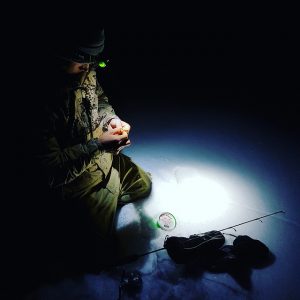Humans are adventurous. However, some of our adventurous expeditions quickly turn to ugly survival situations that test our will to survive. If there was a way to foretell such catastrophic outcomes would come against us, we would do well to prevent them in time.
That is not always possible. So, we are left with only one choice. We have to face the disaster head-on and do everything possible to emerge victoriously. One of the most important survival skills is finding food. If you found yourself close to a water body such as a lake or a river, then fishing would be a great source of food.
But how can you catch fish if you have no fishing gear? Is it even possible? The answer is yes, you can catch fish for sustenance. There many techniques for catching fish in a survival situation. Some of the techniques are legal while other will mean you bend the rules a little bit. We will discuss 9 of such techniques.
Fishing in a Survival Situation
1. Fish By Hand
Very primitive indeed but fishing by hand is the way to go if you really need fish for food yet you have no fishing gear. In hand fishing, you will need to grab fish by your hands in its watery lair. The technique has various names depending on your geographical location. You could call it noodling, hogging, graveling, gurgling, cat fisting or stamping among other names. |
Regardless of how you call it, hands-on fishing requires that you visually target the fish so that you can grab it. It is easier done on clear waters where you can see fish clearly. But you can also do it on murky water. Ensure you wear some heavy duty gloves to protect your hands from the murky waters and the sharp fish fins.
2. Use a Fish Spear
Spear fishing has been used in the past by many traditional fishermen. You can borrow the technique to use in a survival situation. You can improvise a spear by chopping the end of a sturdy stick to a sharp point. Alternatively, you can tie your knife at the end of the stick to form a spear.
It is a daunting task to pierce the slippery scales of most fish species. Besides, their streamline body makes them too agile to target easily. Refraction of images in water is also a major challenge. Thus you have to be smart to accurately target fish with a spear while in the water. Spear fishing may a difficult technique but it is worthwhile in a survival situation.
3. Using Nets
There are two kinds of nets for fishing. You can use a gill net or a dip net. A dip net will catch fish that tries to pass through the eyes of the net. They will become entangled. Gill nets are very effective if you place them on the migratory paths of fish. However, they can also catfish that is swimming randomly.
Dip nets, on the other hand, is the one they fishermen usually use to land fish they catch by a hook and a line. You can use the net as a standalone fishing technique in a survival situation. Simply use the net to scoop fish that is swimming oblivious to its surroundings.
4. Poisoning Fish
This may be illegal in most jurisdictions. However, you may have no choice in a survival situation. Use this technique only if you are in a dire situation as a last resort. You can extract the fish poison from certain plants materials in the wilderness. The plants will release some chemical compounds into the water that will stun or kill fish.
Traditionally, fish poisoning technique has been used in small ponds and pools with still water. Nevertheless, you can use it successfully in rivers and even large water bodies. The poisons may be deadly for fish but they are always harmless to humans. So, you do have to worry about your safety.

Ice Fishing in a Survival Situation
5. Hook and Line Sets
Another effective way to procure fish in a survival situation is to use a series of hooks and lines set tied to a small raft. Alternatively, you can tie the sets on a long stick. You do not need bait. Just leave you makeshift fishing gear out afloat in the pond or pool of water for the night.
You may be lucky to catch a couple of fish when you check in the morning. The technique is not legal in sports fishing. However, you can do it if you are in a survival situation. Many survivors have successfully used this technique. So, you may find it useful in a true survival situation.
6. Use of Striking Iron
Another technique for catching fish is by using a striking iron. The method is may be crude and strange but it guarantees you a meal in a survival situation. It works just like the name suggests. Use a striking rod to target a slow-moving fish as it comes to the surface. An accurate strike will stun the fish allowing you to collect it. A slender metal bar could also work in the same way as a striking iron.
7. Fishing with a Fish Weir
A weir can me many things. It can be a wall, a large funnel or circular fence designed to direct a shoal of fish into your laid trap. You can learn to make a fish weir by designing one like the traditional ones that are still in existence. The traditional weirs are great because they still work.
In a survival situation, it would be impractical to build a brick wall in a survival situation in the wilderness. You can build a weir by driving posts or stakes into the sand or mad at the bottom of the pool or pond. A weir is good because it can also help boost your success with dip netting and spear fishing efforts.
8. Use of a Basket Trap
Improvising a basket trap to catch fish is an effective technique for catching fish in the wilderness. All you need is a container featuring a funnel-shaped opening. The size of the container you use should depend on the size of the fish type you intend to catch. Another determinant is the behavior pattern of that fish.
Build your trap to fit the fish types in the pond or pool. For instance, you can make a basket trap for minnows by using a soda bottle. Cut off the neck of the soda bottle and invert it inside the bottle. You can improvise with any container depending on the size of fish you target to catch.
9. Fishing with a Trot Line
A trotline works well in still waters and rivers. It is made up of a number of baited lines that dangle off a single line that is suspended between two anchor points. The commonly used anchor points are trees or limbs proximal to the water. This technique works well at bank lines.
You will need to secure the dangler lines along the length of the long line. Leave enough space between the danglers. This will prevent them from tangling underwater especially under the weight of live bait swimming on the hooks. The excellent baits for this application are live minnows, small panfish and crayfish.
Conclusion
When things go wrong, it is best you are found prepared. Learning the different techniques for catching fish in a survival situation is one of the ways to increase your chances of emerging victorious. There are many other techniques but we feel the 9 we have described are the easiest to master. They will also guarantee you success. Practice them now and get fully prepared before a disaster strikes.
Having decent fishing gear is important if you’ll be going frequently. Gear Lobo did a review on Berkley Trilene fishing line, and has some other great gear recommendations as well.
